Acupuncture & TCM Articles
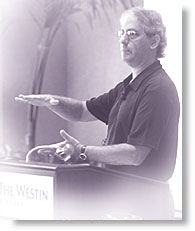
Articles by Jake Paul Fratkin, OMD, LAc
Jake Fratkin, OMD, LAc, has been in the practice of Oriental medicine since 1978. Following undergraduate and graduate training at the University of Wisconsin in Chinese language and philosophy and pre-medicine, he pursued a seven-year apprenticeship in Japanese and Korean style acupuncture with Dr. Ineon Moon and a two-year apprenticeship in Chinese herbal medicine with Drs. Zhengan Guo and Pak-Leung Lau in Chicago. He also spent a year in Beijing hospitals interning in advanced herbal medicine, specializing in gastrointestinal and respiratory disorders, and pediatrics. 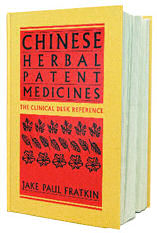 Dr. Fratkin is the author of several books, including Chinese Herbal Patent Medicines: The Clinical Desk Reference, and is the editor-organizer of Wu and Fischer's Practical Therapeutics of Traditional Chinese Medicine. In 1999, he was named the "Acupuncturist of the Year" by the American Association of Oriental Medicine.
Dr. Fratkin is the author of several books, including Chinese Herbal Patent Medicines: The Clinical Desk Reference, and is the editor-organizer of Wu and Fischer's Practical Therapeutics of Traditional Chinese Medicine. In 1999, he was named the "Acupuncturist of the Year" by the American Association of Oriental Medicine.
Chinese Herbal Patent Medicines: The Clinical Desk Reference
Hardback book, 1198 pages. This volume covers 1360 products, including 550 GMP level products and all of California FDB analysis on 505 products. Includes information on endagered animals, heavy metals, and pharmaceuticals. The text is organized into 12 groups, with a total of 109 chapters and includes material by Andrew Ellis, Subhuti Dharmananda, and Richard Ko. Over 80 pages of full-color photos (with English and Chinese cross-reference). Fully indexed.
Treating Complex Multi-Layer Cases, Part 1: Diagnosis
Often, a new patient comes into the clinic with a variety of complaints, each layered on top of each other. A woman's main complaint might be fatigue, but in interviewing her, we find that her periods are irregular, she has abdominal bloating and gas, poor sleep and headaches once or twice weekly.
We herbalists work best when there is an isolated complaint. So where do we start in this case? Headache, menstrual irregularity, abdominal distension, insomnia? If we could isolate a chief complaint, TCM presents us with various differentiations that guide our formulation of a prescription or choice of an herbal product. Too often, like this patient, the complaints are multiple and coexistent. My recommendation is to ignore the complaint picture and use your diagnostic skills to determine excess or deficiencies in the various zang fu organs. This information will help you decide with which prescription to begin treatment.
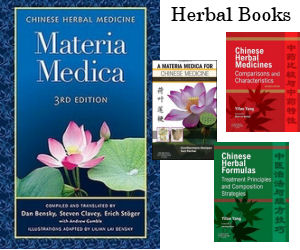
Prioritizing the first formula is best done by pulse taking, supported by abdominal palpation. In pulse, we are looking at two different paradigms. The first is general pulse and the second is excess or deficiency on the various pulse positions.
The key step is reading the pulse correctly. The patient should not be wearing a watch or heavy jewelry on the wrist. The patient can be seated or lying down.
The patient's arm should never be raised vertically, because gravity can affect the pulse reading. Keep the arm horizontal. Cradle their hand in yours - the one that's not taking the pulse - and gently pull and extend the hand so that their thumb points forward, in line with their arm. This keeps their thumb from pointing upwards, and the elongation allows better access to their cun-distal pulse. Your hand should cradle their hand with your thumb gently holding down their thumb.
Whole-Pulse Diagnosis
Whole-pulse diagnosis refers to feeling the whole pulse with three fingers on each wrist. Some practitioners, especially those in Japan, prefer to feel both wrists at the same time, but I prefer to take one wrist at a time. While there are 28 aberrant pulses detailed in TCM training, 10 are particularly important. These are the three pairs of floating-sinking, rapid-slow, excess-weak, and then the special qualities of choppy, wiry, slippery and tight. I do not need to go into detail here, because this is part of everyone's TCM training. It's good to do whole-pulse diagnosis before proceeding into individual positions. I carefully examine the whole pulse and pose the same questions in the same sequence: Is this pulse floating or sinking? Is this pulse fast or slow? Is this pulse showing excess or deficiency? Is there any quality of wiry, slippery, choppy or tight? While the answers influence my treatment, whole pulse is not my primary interest. It provides a backdrop against the information I look for in positional diagnosis.
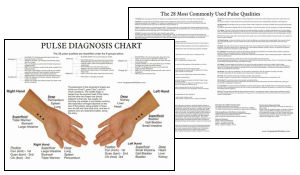
Pulse Diagnosis for Zang Fu Positions
In zang fu positional pulse diagnosis, the most important observation concerns excess versus deficiency in each of the 12 positions. I recommend using the middle finger for the guan-middle position, the index finger for the cun-distal position, and the ring finger for the qi-proximal position.
I start pulse diagnosis by looking at the guan-middle position of one wrist only. Find the high point of the radial stylus, and allow your middle finger to find the pulse. Go to the middle level; the dead center of the vessel. This represents the qi and blood of the associated element/phase, Wood on the left, and Earth on the right. Feeling the middle of the pulse, raise your pressure slightly so that you come to the surface of the vessel, the upper-outer skin of the artery. This will be the yang aspect of that position (e.g., Wood or Earth, if in the guan-middle position). If you leave the surface of the radial artery, you are not on the pulse anymore. You are in the interstitial fluid and tissue, which is not the pulse. Go back to the middle position and go deeper to find the lower border of the radial artery. This is the yin aspect of that element/phase. If you go too deep, you again are in the interstitial fluid and tissue rather than on the pulse. Of course, if you hit bone, you are way too deep. So, just to be clear, the upper-outer edge of the sleeve of the artery is the yang aspect, and the lower edge of the artery is the yin aspect. I usually walk back and forth several times, like climbing up and down three stairs, on each finger position to confirm what I am feeling.
After examining the guan-middle position with your middle finger, I next go to the index finger to determine the yang and yin aspects of the cun-distal position, either Metal on the right hand or Fire on the left hand. The cun-distal pulse is more superficial than the guan-middle position because the artery is coming closer to the surface. Again, it is most important to find the middle of the artery first and then lighten the touch to feel the superficial aspect, going back to the middle then find the real pulse, then slightly deeper to find the bottom sleeve of the artery position.
Finally, I go the qi-proximal position (Kidney mingmen fire on the right or Bladder-Kidney on the left). Here, the pulse dives rather deeply and it is important to find the middle part of the pulse first, then determine yang and yin aspects.
Determining Excess and Deficiency
I am most concerned with excess and deficiency. In excess conditions, certain zang fu positions of the pulse will be wiry. This wiriness can be in either the superficial aspect of the pulse (the yang), or in the deeper aspect (the yin). If all of the superficial pulse positions are in excess, there is an exogenous pathogenic wind invasion, or acute trauma or shock. Normally, the excess will be in isolated pulse positions. Accordingly, I look at each position in isolation. In chronic cases with multiple complaints, wiriness is often found in the guan-middle position. If excess is found only in the left guan-middle position, this shows excess in the Gallbladder meridian or the liver organ. Pressing deeper to the bottom edge of the vessel, in the middle position left side, will show more about the status of the liver. If this position is wiry, we can confirm that there is stagnation of liver qi and/or blood. If there is a weakness in the deeper liver position, we can say that there is liver stagnation of qi and/or blood (taken from the superficial wiriness), plus a deficiency of either liver blood or yin. Liver blood deficiency would be confirmed by dryness in the skin or hair, pale conjunctiva or ridges in the fingernail, plus signs such as amenorrhea or light menses. Liver yin deficiency would be deduced by the absence of blood deficiency signs. In more pronounced cases, we would find the patient reporting dryness of the eyes or vagina.
If wiriness is not found on the left wrist, but on the right guan-middle position at the superficial aspect, this implies stagnation of stomach qi, and the failure of stomach qi to descend. Examining the deeper portion of the Earth pulse; if this position is normal, then spleen qi is not necessarily involved. If the spleen position is weak, then we diagnose a deficiency of spleen qi.
If both the superficial Wood and Earth pulses are excess, we can diagnose liver qi stagnation causing stomach qi stagnation. In this case, both liver and stomach aspects would need to be addressed in treatment. If deficiencies also appear in either the spleen or liver, these need to be taken into account in the final construction or choice of the herbal formula.
In conclusion, most complex layered cases that enter the clinic will show excess/deficiency patterns affecting the liver, stomach and spleen. Our job, as herbalists, is to evaluate the various stagnation and deficiency patterns and to apply the appropriate herbal formula.
Pulse Diagnosis Books
Pulse diagnosis, The Pulse Classic, The Lakeside Master's Study of the Pulse, Chinese Pulse Diagnosis.
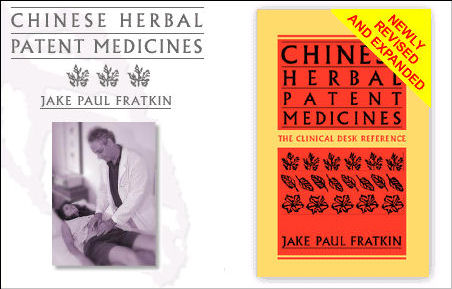 
|
